Contributory members are able to log private notes and comments about each site
Sites Anne T has logged. View this log as a table or view the most recent logs from everyone
Slidey Stane (Holyrood Park)
Trip No.106 Entry No.4 Date Added: 5th Nov 2018
Site Type: Natural Stone / Erratic / Other Natural Feature
Country: Scotland (Midlothian)
Visited: Yes on 28th Oct 2018. My rating: Condition 3 Ambience 3 Access 4
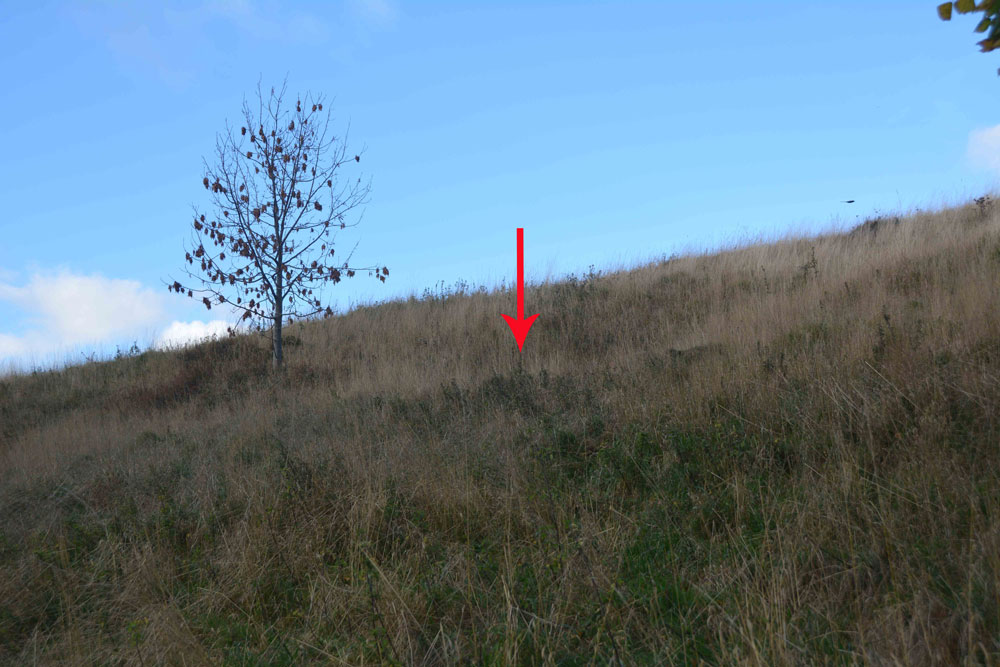
Slidey Stane (Holyrood Park) submitted by Anne T on 5th Nov 2018. The Slidey Stane is well hidden on this hillside, from above and below. From the path below, all that can be seen is a small dip in the slope of the hill. Similarly from the footpath running above the stone, although there are much larger chunks of bedrock sticking up at the side of the path.
(View photo, vote or add a comment)
Log Text: The Slidey Stane, Holyrood Park: As we were in Edinburgh City Centre, we thought we'd try and find this large erratic stone which is featured on The Ancient Stones website, but my goodness - what a search we had!
We followed the directions given on The Ancient Stones, and even armed with the GPS we walked up and down and down and up and round and round. Eventually, I took my phone out and managed to find a forum post on the Modern Antiquarian which gave a link to a search by the park rangers. This, thankfully, included photographs of the route to find the stone. It is in fact at the location given by the Ancient Stones, but is so hidden in a dip on the hillside, that we were unable to see it, either from below or above. We finally saw it from a couple of metres away, but what a disappointment!
The stone is small, although the top is shiny as if it has been polished over the years. There are larger stones on the footpath running above the Slidey Stone.
Well, at least we found it, photographed it and have now posted the results here. We too a more accurate grid reference of NT 26766 72765.
Caiy Stane
Trip No.106 Entry No.2 Date Added: 5th Nov 2018
Site Type: Standing Stone (Menhir)
Country: Scotland (Midlothian)
Visited: Yes on 28th Oct 2018. My rating: Condition 3 Ambience 4 Access 5
Caiy Stane submitted by crannog on 22nd Feb 2012. Edinburgh council has to be commended for the care they take in preserving ancient sites/monuments, like this. It is located at the end of a street with lots of homes all around.
(View photo, vote or add a comment)
Log Text: The Caiy Stane, Edinburgh: It was a good job we had the SatNav to help us find this stone, as all the streets around were called ‘Caiy (something)’ and we could have been driving around for ages!
This is a magnificent stone, set back in a niche backing onto someone’s garden on Caiystane View. It is possible to walk all the way around it, so we saw the 6 cups marks and the more modern graffiti on the back face.
The small sign at the front base of the stone reads: “The Caiy Stone. The Property of The National Trust for Scotland.” The larger sign, on the low wall to the left of the stone reads: “The Caiy Stane. Standing at over nine feet high on a summit, originally with wide views, this broad slab of red sandstone includes a line of six, probably prehistoric, cup marks on its reverse face. / The stone may have been erected as early as the Neolithic period, possibly before 3000BC, to denote a ritual or burial place. Records of cairns, cists and urns found in the immediate vicinity show that the hilltop continued to be used for burial in the Bronze Age. / Discovery of these remains led to the supposition that Caiyside Hill was the site of a battle, variously suggested to have involved Romans, Danes (Vikings); ore Cromwellians. The Caiy Stane, also known as the Kel Stane, the Cat Stane or the Camus Stane, was thought to have been a battle memorial stone.”
Buck Stane
Trip No.106 Entry No.1 Date Added: 5th Nov 2018
Site Type: Standing Stone (Menhir)
Country: Scotland (Midlothian)
Visited: Yes on 28th Oct 2018. My rating: Condition 3 Ambience 4 Access 5

Buck Stane submitted by Creative Commons on 15th Jan 2014. The Buckstane. The inscription reads:
This march stone, a relic of feudal times occupied a commanding site on the old Roman road about 250 yards north of this spot.
By tradition the name was derived from the stone having marked the place where the buckhounds were unleashed when the King of Scotland hunted in this region.
Copyright Callum Black and licensed for reuse under the Creative Commons Licence.
(View photo, vote or add a comment)
Log Text: The Buck Stane, Braid Road, Edinburgh: Our first stop of the day in the Tour of Edinburgh Stones. The Buck Stone is in a niche on the western side of Braid Road, about 125m north of the junction with Buckstone Drive and before it turns into Buckstone Terrace.
There is a sign explaining what the stone is: The Buckstane. This march stone, a relic of feudal times, occupied a commanding site on the old Roman road about 250 yards north from this spot. By tradition the name was derived from the stone having marked the place where the buck hounds were unleashed when the king of Scotland hunted in this region”.
A nice, tidy, well looked after spot.
Easter Broomhouse
Trip No.105 Entry No.8 Date Added: 5th Nov 2018
Site Type: Standing Stone (Menhir)
Country: Scotland (East Lothian)
Visited: Yes on 27th Oct 2018. My rating: Condition 3 Ambience 4 Access 4
Easter Broomhouse submitted by cosmic on 1st Jun 2008. Site in East Lothian:
Viewed from SE
(View photo, vote or add a comment)
Log Text: Easter Broomhouse Standing Stone: Dusk was falling as we arrived at this site, which I've long wanted to see. We parked by the water treatment works over the road at NT 67718 76493 and walked down the side of the ploughed area of the field until we were level with the stone, then ‘waded’ through the loose, ploughed soil until we reached the stone itself.
A lonely spot, although it has great views to the Firth of Forth and Bass Rock in the distance, to the north. It is a tall, sandstone pillar standing in an ocean of brown-red soil.
There are indeed 3 cups marks on its western face, along with some modern graffiti. The base of the stone has really been worn away; as the Canmore record says, this is the result of a steam plough cable.
St John's Well (Spott)
Trip No.105 Entry No.7 Date Added: 5th Nov 2018
Site Type: Holy Well or Sacred Spring
Country: Scotland (East Lothian)
Visited: Yes on 27th Oct 2018. My rating: Condition 3 Ambience 3 Access 4
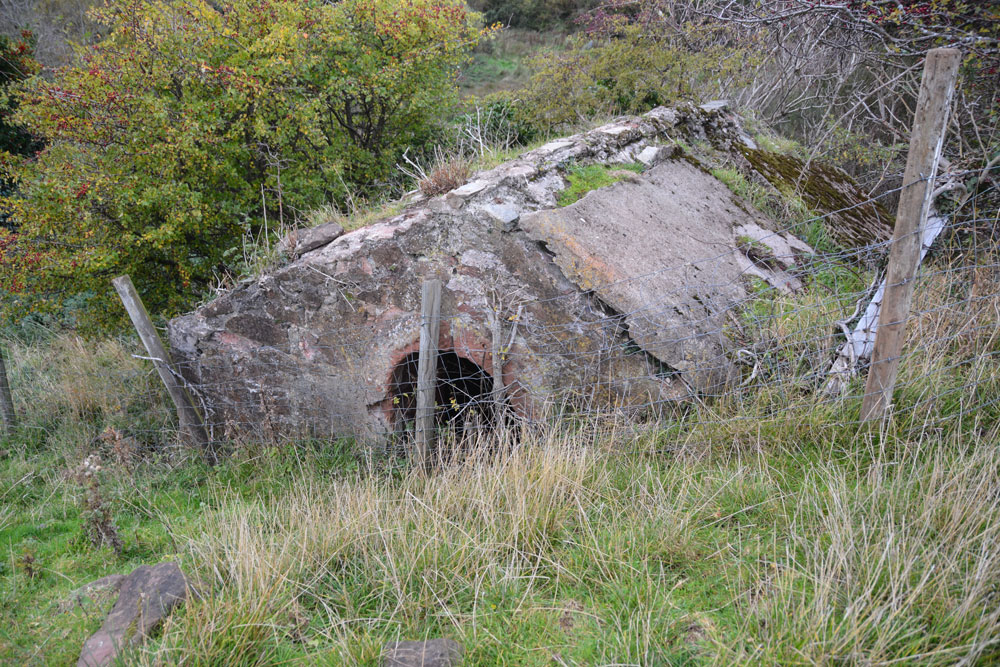
St John's Well (Spott) submitted by Anne T on 5th Nov 2018. This old cistern is some 100m further north, at the eastern side of the gully running from the well. I wondered if it was part of the 18th century works which piped water from this well into Dunbar.
(View photo, vote or add a comment)
Log Text: St John's Well, Spott: With the wind still whistling and starting to get dark, we really wanted to see this well and the nearby Easter Broomhouse standing stone before calling it a day. At the north eastern end of Spott, a gated stile by the small school lets you into the field, which, at the time of our visit, was full of very large, curious sheep.
Following the line of the first two telegraph poles, a gully comes into view. The well house is located at the top of this, at the bottom of the gully, so we needed to slither down the 6ft or so to the bottom to photograph the well.
Whilst the well cavity was dry, there was a pool of water a couple of metres further down the gulley.
Further down the field there was a very old, ruined building with an arched window. I am curious to know what this is – need to look it up on Canmore. Because of its location, my immediate thought was that it was a hermitage. No separate Canmore record, but is recorded on the map as a cistern.
Witches' Stone (Spott)
Trip No.105 Entry No.6 Date Added: 5th Nov 2018
Site Type: Holy Well or Sacred Spring
Country: Scotland (East Lothian)
Visited: Yes on 27th Oct 2018. My rating: Condition 3 Ambience 3 Access 5
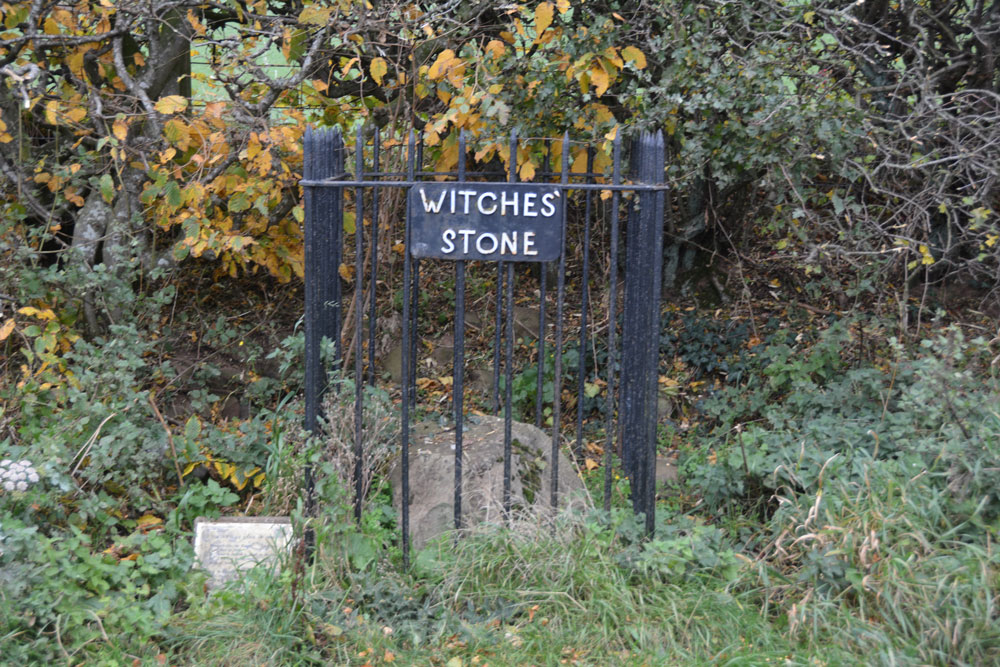
Witches' Stone (Spott) submitted by Anne T on 5th Nov 2018. This unprepossessing stone sits beneath a hedgerow, with a name sign and a small (now almost illegible information sign).
(View photo, vote or add a comment)
Log Text: The Witches' Stone, Spott: I had expected something a little grander than a large stone by the side of a hedgerow with a rusting iron railing and a sign that we could hardly read. There is a photograph on the Canmore record with a photograph of the sign from 2010 which is legible: “The Witches Stone of Spott. Marion Lillie, the Ringwoody Witch was burnt here in 1698. The stone is reputed to stand on the site of the burning of the last witch in the South of Scotland. Near to this site the Birley Tree stood, under whose branches the local Birley Court was held.”
I had to chuckle as whilst I was photographing a stone, another couple had stopped to take photographs of a brown sheep in a nearby field. Having taken quite a few photos, they continued their walk, walking right by this stone. Perhaps they’d seen it before. I found it touching that people still left coins here as offerings.
Gogar Stone
Trip No.105 Entry No.6 Date Added: 6th Nov 2018
Site Type: Standing Stone (Menhir)
Country: Scotland (Midlothian)
Visited: Yes on 28th Oct 2018. My rating: Condition 3 Ambience 4 Access 4

Gogar Stone submitted by Andy B on 13th Mar 2010. Standing stone at Gogar
Copyright M J Richardson and licensed for reuse under the Creative Commons Licence.
(View photo, vote or add a comment)
Log Text: The Gogar or Easter Norton Standing Stone: The last time I visited this stone, the field was planted with crop with no easy way of crossing the knee high rows of plants, so we viewed it from a distance. On this visit, the field had been left fallow, so we parked in the small layby on Freelands Road and walked through a gap in the hedgerow up to the stone. A large rook was perched on top of the stone, but flew off before I could take a photograph of it.
This stone has lots to keep it occupied during the day – planes taking off from Edinburgh airport to the north, trains on the mainline to the south, and cars on the M8. It was nice to be able to wander up to it, take photographs and see the stone up close.
The satnav took us by a funny route back to the A8 and whilst waiting to move off, a white van ran into the back of our car, just as a blue light ambulance was trying to get past. Not a good end to the day, but we decided to stop off at the Boar Stone on the way back as there was still just enough daylight.
Rood Well
Trip No.105 Entry No.5 Date Added: 5th Nov 2018
Site Type: Holy Well or Sacred Spring
Country: Scotland (East Lothian)
Visited: Yes on 27th Oct 2018. My rating: Condition 4 Ambience 4 Access 5
Rood Well submitted by KiwiBetsy on 2nd Oct 2006. The Rood Well, also known as The Well of the Holy Rood or the 'Cardinal’s Hat', sits beside the B6370. It is located in a small garden area on the northeastern edge of Stenton, on the left if you are heading for Dunbar.
(View photo, vote or add a comment)
Log Text: Rood Well, Stenton: A very pretty well, and very easy to find. Just by the side of the road, some 300 metres north east along the B6370 from The Tron. The well is below pavement level, with steps leading down to it. The well cavity was damp but there was no pool of water. I couldn’t see any pipe leading into the well chamber, so assume the water must seep up into the cavity. Being closely surrounded by a stone wall on three sides, with a ploughed field beyond, it was a little tricky to photograph.
As the Canmore entry from the Old Church (ID 57841) says, the finial on the well is thought to come from the Old Church (14th century). There is a small plaque on the side of the well which reads: “16th century historic building”.
Mayshiel Stone Circle
Trip No.105 Entry No.4 Date Added: 4th Nov 2018
Site Type: Stone Circle
Country: Scotland (East Lothian)
Visited: Yes on 27th Oct 2018. My rating: Condition 3 Ambience 4 Access 4
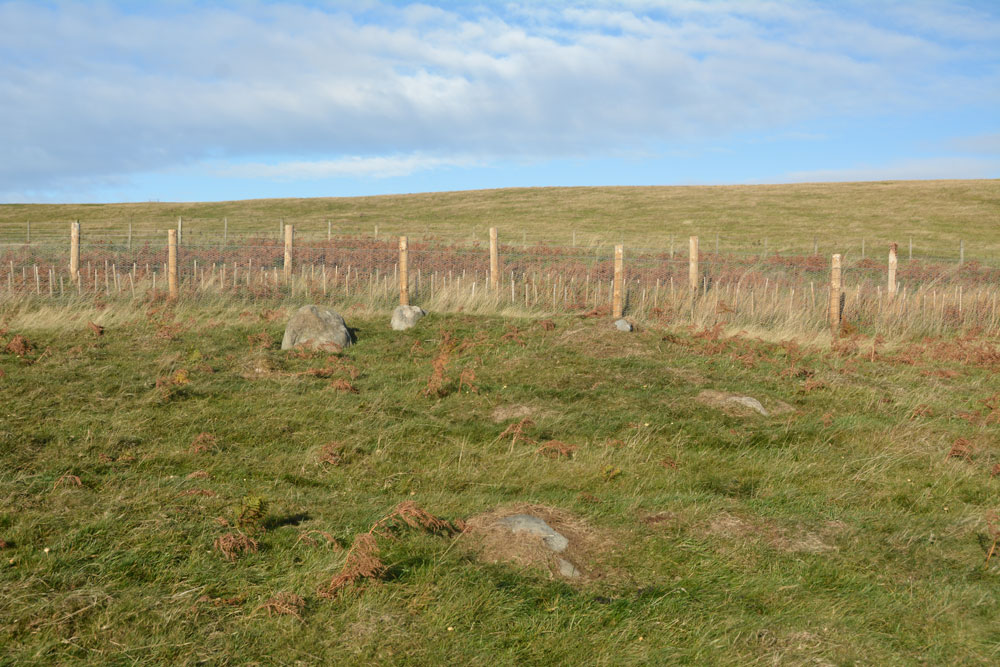
Mayshiel Stone Circle submitted by Anne T on 4th Nov 2018. The Mayshiel stones from the south. At the top of the slope, there were five stones which protruded out of the grass. Looking more closely, there were some further down-slope, largely hidden by turf, but nevertheless still part of this stone setting.
(View photo, vote or add a comment)
Log Text: Mayshiel Stone Setting: Whilst we were here to see the stones at NT 6298 6465, the first thing I spotted was a huge pile of clearance stones just up the hill in a field just north of the B6355. The second was what looked like a standing stone at the edge of the field at NT 62924 64612. On closer look, this may have been a large field clearance stone, which sits on top of other small boulders.
The stones at Mayshiel are very close to the road. At first glance, there are only three, but the longer we looked, more became evident.
There were also another group of stones at approx. NT 62814 64541 which had the appearance of a cist, but the stones forming the longer sides were very large. These stones may have just been a natural outcrop. One of the stones had been broken and the split off bit was lying half way along the northern end of the group.
Looking at the latter group of stones at home, they were similar in description to Canmore’s description of the Packman’s Grave (above).
At first glance, an insignificant site, but the more we walked round, the better it became, and it was well worth stopping off to look at this.
Packman's Grave (Whiteadder Reservoir)
Trip No.105 Entry No.3 Date Added: 4th Nov 2018
Site Type: Stone Row / Alignment
Country: Scotland (East Lothian)
Visited: Couldn't find
Log Text: Packman's Grave, Whiteadder Reservoir: Despite having the grid reference, we were unable to find anything at this site, which was disappointing. We did find something remarkably similar at NT 62814 64541 - five stones in a kite-;ike shape, not far to the south west of the Mayshield Stone Setting.
Hanging Stanes (Braid Road)
Trip No.105 Entry No.3 Date Added: 5th Nov 2018
Site Type: Marker Stone
Country: Scotland (Midlothian)
Visited: Yes on 28th Oct 2018. My rating: Condition 2 Ambience 3 Access 5
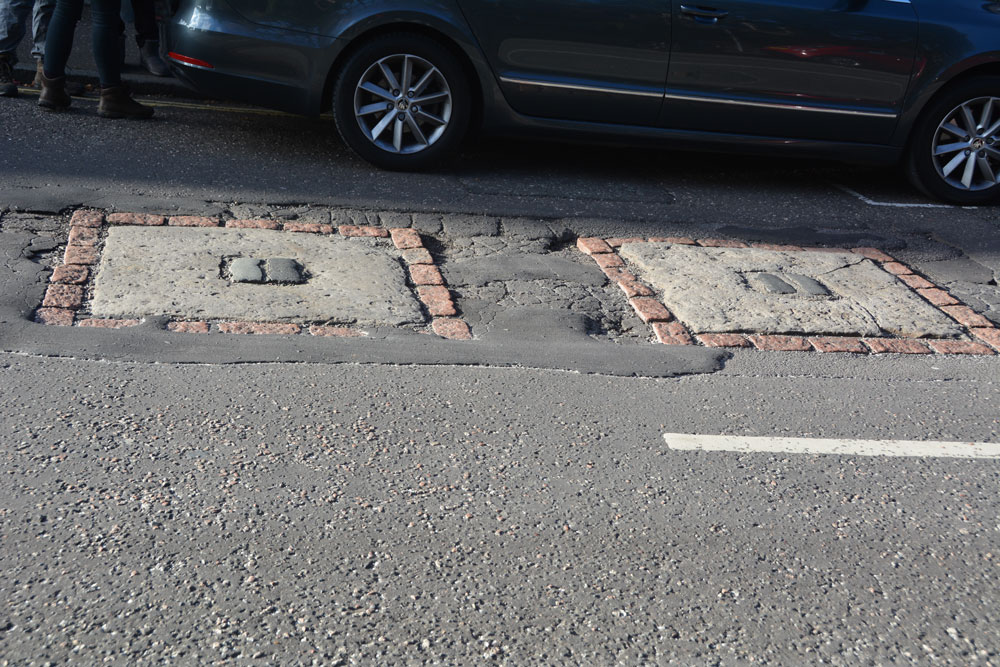
Hanging Stanes (Braid Road) submitted by Anne T on 5th Nov 2018. The two gallow bases are embedded in the road surface. I originally thought this site was associated with witches, but was the site of the execution of the last two highwaymen in Scotland. We picked this site up from the Ancient Stones website, and as it was very close to the Buckstane, thought we'd take a look.
(View photo, vote or add a comment)
Log Text: The Hanging Stanes: Having spotted this site on the Ancient Stones website, and with them being just down the road from the Buck Stane, we decided to pay this site a visit on the way into Edinburgh City Centre. I don't know why I thought these were originally associated with witches, but found out otherwise during the visit.
We pulled up next to the junction of Braid Road and Comiston Road, as per the directions on the Ancient Stones, only to find some people from the house immediately next to it were leaving and getting into their car. The older gentleman from the house asked me if we’d seen the plaque on the street and told me around 30 people each day come to see these stones.
The plaque in the pavement reads: “The Hanging Stanes. Thomas Kelly and Henry O’R eil, the last two highwaymen in Scotland to be executed, were hanged in public on 25th January 1616, from the gallows erected on the two stanes still visible on the spot, which was where the robbery took place. Paid for by public subscription. 1995.”
I risked getting run over to avoid my shadow falling across the stones, but they were half in shade and half in the sun, so the photos weren’t great. With these stones being sited on the slope of a hill with views over the city centre, without the traffic and the people around, this would have been a very atmospheric and enigmatic place.
Whiteadder Reservoir
Trip No.105 Entry No.2 Date Added: 4th Nov 2018
Site Type: Cairn
Country: Scotland (East Lothian)
Visited: Yes on 27th Oct 2018. My rating: Condition 2 Ambience 4 Access 4

Whiteadder Reservoir submitted by Anne T on 4th Nov 2018. This appears to be all that is left of the stone setting and cairn, although the grass and bracken were mid-calf height, so other stones could have been hidden underneath. The cairn is easily identifiable, as it stands above the surrounding ground level, with a stone emerging from one side of the centre of the mound. This view is looking west north west over the cairn.
(View photo, vote or add a comment)
Log Text: Whiteadder Reservoir cairn and stone setting: We parked at NT 64304 64291 and walked along the first part of the Herring Road onto the land high above Whiteadder Reservoir with the GPS to find this stone setting and enclosure, with the cold winds whipping around our ears. From what I'd read on Canmore, I expected something a little different from what we found on the ground, which was in effect a cairn.
Despite walking round the area looking for these stones, and trying to feel for stones under our feet, we only found what looked like a cairn with one stone sticking up out of it. It is the same area as that given by Canmore. A 1971 entry says the enclosure has been completely destroyed, except "three small stones exist." As the grass and heather was calf deep, it was probable the stones were hidden underneath.
Looking at the map on the Canmore record, the cairn we spotted is in the correct location for the stones, with the enclosure about 20m to the south, identifiable as there is a flat, circular area in the bracken. Beautiful views over the reservoir.
The sign on the ‘public path’ signpost reads: Heritage Path, Herring Road. This old path is named because it was used by the fishwives of Dunbar when carrying massive creels of herring to market in Lauder. This track was one of many different routes that were used by the fishwives over the centuries as paths became eroded and were replaced.” And “Herring Road to Dunbar, 12.5miles via Dunbar Common and Halls”.
Duns Mercat Cross
Trip No.105 Entry No.1 Date Added: 4th Nov 2018
Site Type: Ancient Cross
Country: Scotland (Scottish Borders)
Visited: Yes on 27th Oct 2018. My rating: Condition 3 Ambience 3 Access 5
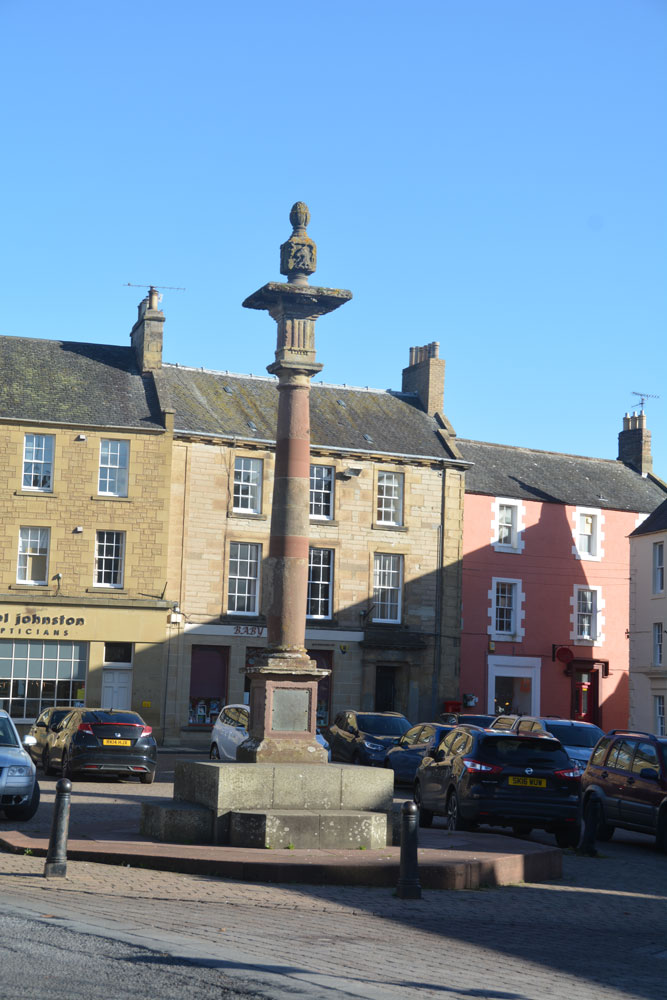
Duns Mercat Cross submitted by Anne T on 4th Nov 2018. The current market cross, moved to its present location in 1897.
(View photo, vote or add a comment)
Log Text: Duns Mercat Cross: Having set off after a snow storm this morning, we stopped off in Duns just after 12 noon for coffee and a scone.
We went to the café we went to when we were here last (some 3-4 years ago), only to find the café open but no-one in, despite many cars in the town. Parking just round the corner from the market square, I realised that there was a market cross which I don’t think I’d photographed before. Whilst the base was ‘modern’ the top appears old.
The café had changed hands, reverting to the original owner, who admitted to being 76 years old and having run a gallery in Harrogate. “We don’t do lunches” we were told. By this time we were cold and hungry so opted for hot scones and tea. A great selection of very reasonably priced antiques to browse round, too, although the only thing I would really have liked to buy wasn't for sale!
The plaque on the cross base reads: “The Mercat Cross of Duns originally stood on the site of the present town hall and was removed when it was rebuilt in 1820. It was re-erected by Andrew Smith Esqr. of Whitchester AD 1897.”
Lady Well (Bavington)
Trip No.104 Entry No.4 Date Added: 25th Oct 2018
Site Type: Holy Well or Sacred Spring
Country: England (Northumberland)
Visited: Yes on 24th Oct 2018. My rating: Condition 2 Ambience 4 Access 4
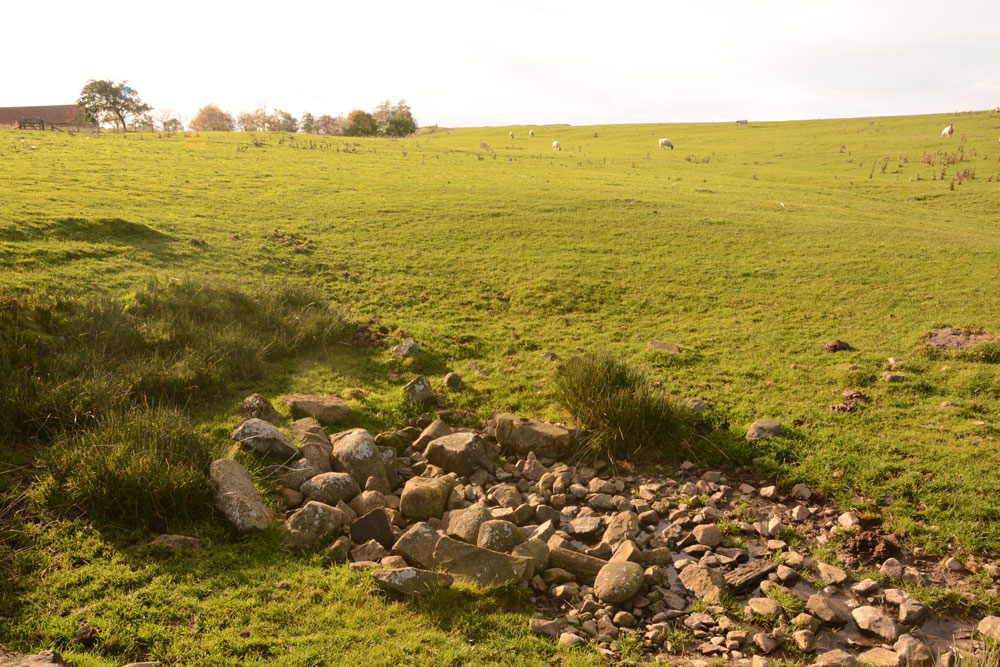
Lady Well (Bavington) submitted by Anne T on 25th Oct 2018. The well from the north east. From the relatively large number of dressed stones at and around the well head, it looks as if there was a well house or structure here at some time. This is the source of the Kirkharle Burn.
(View photo, vote or add a comment)
Log Text: Lady Well, Bavington: This is a lovely spot, and well worth the short walk to and from the road to see this well (or what remains of it).
We parked at NY 99286 80701, just off the B6342, and followed the track northwards towards Ladywell Farm. There was a big boulder with lots of cut marks at it at the top of the track, and I worked out it said ‘Ladywell’ on it, although the marks looked more like runes than letters!
There are no records on Pastscape or HE, although the well is marked on the OS map. Ladywell Farmhouse is recorded as Historic England List ID 1044928, although this is largely 17th and 18th century.
The footpath goes right past the right hand side of the farm, then deviates off slightly north east, through a kissing ate. Walking straight ahead, there was a dip in the ground with some marsh grass around it to our right, so we made a beeline for this. There was a heap of pebbles in the dip, with a stream of water emerging from the ground between the stones – no great rush of water, just a gentle flow. Judging by the dressed stones at the southern end of the pile of pebbles, it looks as through there might have been a well house or pool surround at some point.
Oh the wind, which must have been a steady 30mph plus on our walk there and back! My ears and cheeks burned when I got back into the car after this walk, although it was nice to actually walk to a site and back, even though it was a relatively short distance.
Jemmy's Well (Cambo)
Trip No.104 Entry No.3 Date Added: 25th Oct 2018
Site Type: Holy Well or Sacred Spring
Country: England (Northumberland)
Visited: Yes on 24th Oct 2018. My rating: Condition 3 Ambience 3 Access 4
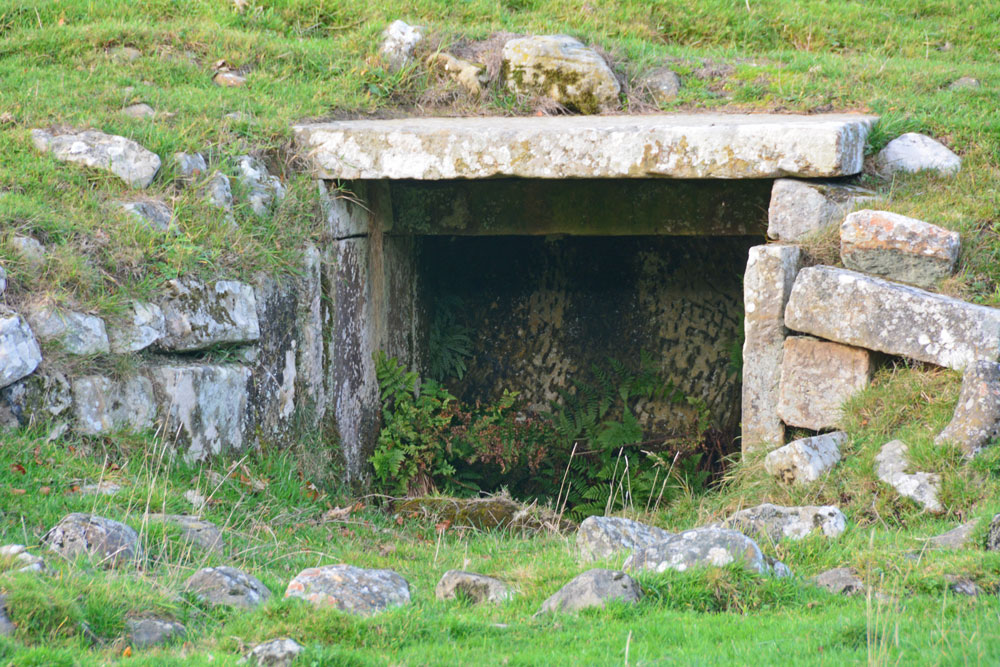
Jemmy's Well (Cambo) submitted by Anne T on 25th Oct 2018. Using the camera lens almost on maximum zoom to try and see the inside of the well house. I will try and get permission to walk across the field and take a closer look in the relatively near future. The half circle of stones outside the well house indicates there used to be a pool at some time in the fairly recent past.
(View photo, vote or add a comment)
Log Text: Jemmy's Well, Cambo: One of three wells in the village of Cambo, but only this one is marked on the modern OS map, and the only mention we found of it was in Binnall and Dodd's 1941 'Holy Wells of Northumberland and Durham' document. The well lies on private land, just south of Cambo School, and the well field had at least half a dozen horses in it; to avoid upsetting the horses, we let ourselves into the field to the south, using the gate near the wood alongside the B6342, then walking north to where a 'bridge/track' has been created over the small stream to the south of the well field.
I found the 1863 OS maps when I got home, and the other two wells are marked, to the south west of Jemmy's Well; where these are the two mentioned by Binnall and Dodds (Hepple's Well and Stinky), I'm not sure, but the are close enough to supply the village.
I'd like to get permission to get into the well field and take a closer look. Whilst the well looked dry at the time of our visit, the semi-circle of stones outside the well house indicated there had been a well pool there at some time in the fairly recent past.
St Cuthbert's Well (Mitford)
Trip No.104 Entry No.2 Date Added: 24th Oct 2018
Site Type: Holy Well or Sacred Spring
Country: England (Northumberland)
Visited: Yes on 24th Oct 2018. My rating: Condition 3 Ambience 3 Access 5
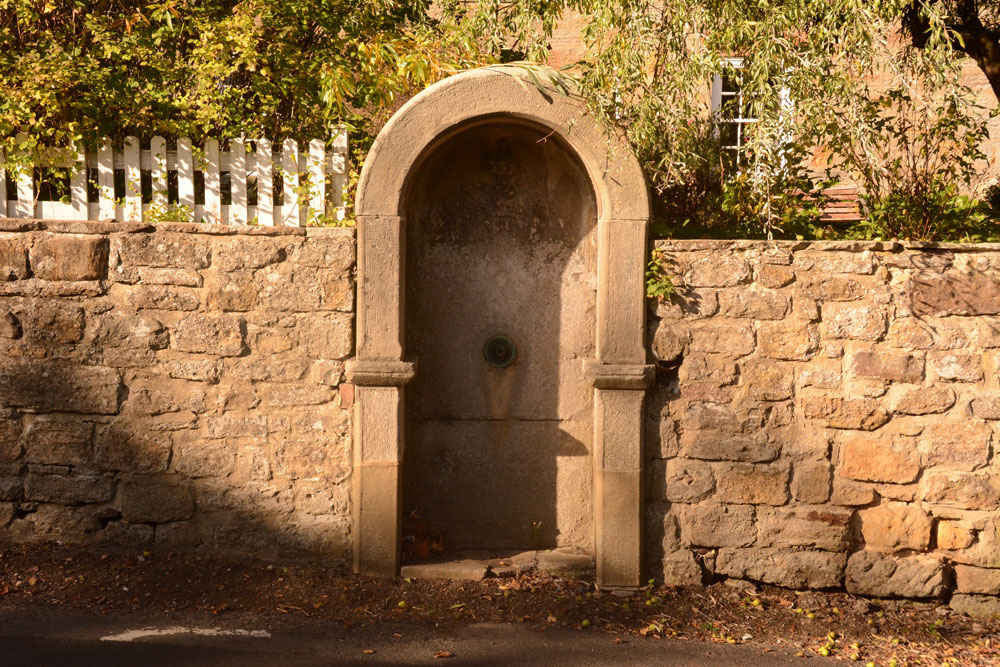
St Cuthbert's Well (Mitford) submitted by Anne T on 24th Oct 2018. The well/fountain housing is built into the wall of the Old Post Office, at the side of the B6343.
(View photo, vote or add a comment)
Log Text: Site of St Cuthbert's Holy Well, Mitford: After having visited Bothal church and spent well over an hour looking around, we stopped off at The Old Chantry tea rooms in Morpeth for a bowl of soup and a cup of tea, then headed off to the small, but very pretty village of Mitford, just over 2.5 km west of Morpeth.
OK, so there is no longer a well here, and the Victorian-era drinking fountain structure that was built in the place where the well was supposed to have been is now dry, it was easy to find. The road is reasonably busy, so I risked getting run over to get a few close up shots. The carving of the impaled dragon's head (I didn't realise what it was until I saw the photos on the larger screen of the computer and read the Historic England description) was pretty gruesome.
We did wander down to the river and walked along a little way. Someone has built what appears to be a very pretty, but very modern, thatched cottage by the side of the footpath along the river.
Note for next time: the pub does special offers on food for pensioners!
St Andrew's Church (Bothal)
Trip No.104 Entry No.1 Date Added: 25th Oct 2018
Site Type: Ancient Cross
Country: England (Northumberland)
Visited: Yes on 24th Oct 2018. My rating: Condition 3 Ambience 4 Access 5
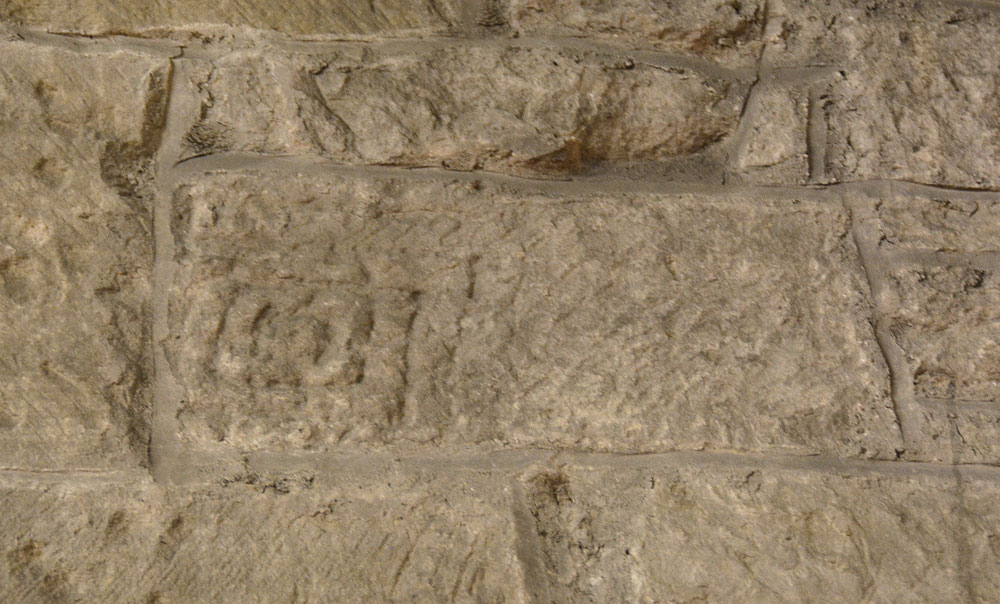
St Andrew's Church (Bothal) submitted by Anne T on 25th Oct 2018. This is AS Corpus Bothal 07, part of a cross shaft built into the north wall of the chancel (towards its western end). Dated to the late tenth to early eleventh century, we initially had difficulty in picking this stone out, but once we'd seen it, could not 'unsee' it. The Corpus describes the pattern as 'formed by concentric punch outlined rectangles with a coiled centre.'
(View photo, vote or add a comment)
Log Text: Anglo Saxon Cross Shaft Fragment, St Andrew's Church, Bothal: I had arranged to collect the key to the church from the Reverend John Parks, who lives in Pegswood. The church in Bothal is very easy to find, and in a very scenic place, with a nearby footpath running down to the River Wansbeck.
The narrow west end of the church faces the road, and is largely hidden by tall, dense trees. My first thought was “how am I going to photograph the outside?” This did prove to be a little bit of a challenge, but in the end, walking into the much larger and spacious churchyard, I managed a couple of shots.
There are a number of entries on HE for St. Andrew’s Church, and whilst we spent about an hour and a half here, I felt I wanted to stay longer to explore all the elements in the guide book and the architectural assessments, but Andrew was getting bored and a cup of tea in Morpeth then holy wells beckoned.
There are several really interesting ‘cut outs’ of the wooden panel in the chancel that give viewing access to a remnant of medieval plasterwork, an old tombstone reused as a lintel, and an old wooden door. The cut outs were quite small, which made photographing these features a little tricky. At one point, I thought I was going to drop the camera down the small window on the south wall of the chancel, in an attempt to photograph the bottom of the lintel above! Photographing the remnant of medieval plasterwork was interesting, as Andrew had to shine the torch (kindly provided by the church in a neat holder next to the grille) whilst I manually focussed the camera. Not a great photo by any means, but I had fun trying!
On the eastern and northern external walls of the church there are musket ball holes.
Bedlington Market Cross
Trip No.103 Entry No.4 Date Added: 13th Oct 2018
Site Type: Ancient Cross
Country: England (Northumberland)
Visited: Yes on 11th Oct 2018. My rating: Condition 3 Ambience 3 Access 5

Bedlington Market Cross submitted by Anne T on 13th Oct 2018. The Bedlington Market Cross (or obelisk), which is very different from the style of other market crosses in Northumberland and the Scottish Borders that I've seen (so far). The top obelisk looks much more modern than the pedestal, although the two are apparently of the same age.
(View photo, vote or add a comment)
Log Text: The Market Cross, Bedlington: We spotted this rather unusual market cross on our way to St Cuthbert's Church to see the tenth century carved slab, now inside the church. The road was less busy on our return, and we managed to pull into the small car park outside the hairdressers opposite (it was shut for the night) and I walked across the road to take some photographs.
I have to confess this is a pretty ugly structure, and well done to whoever uses it as a private parking spot. I was surprised to find this was a Grade II listed structure, built apparently in 1792.
The surrounding flower beds and town signs all proclaimed "The Bedlington Terrier", so presumably this is where those dogs originated.
St Cuthbert's Church (Bedlington)
Trip No.103 Entry No.3 Date Added: 13th Oct 2018
Site Type: Sculptured Stone
Country: England (Northumberland)
Visited: Yes on 11th Oct 2018. My rating: Condition 3 Ambience 4 Access 4

St Cuthbert's Church (Bedlington) submitted by Anne T on 13th Oct 2018. This carved stone, AS Corpus Bedlington 01, has now been built into the west wall of the nave, inside. The lighting is not brilliant, as it is sited immediately underneath the floor of the organ loft, and even with a flash, this was almost beyond my photographic skills. Dated to the tenth century, this worn slab has two figures, both with halos, the right hand figure holding a rod and with its right hand raised in blessing.
(View photo, vote or add a comment)
Log Text: St Cuthbert's Church, Bedlington: The Corpus told us the stone we were looking for was on the external east face of the nave. We were joined by a group of four boys who wandered into the churchyard and wondered what we were doing, so I told them, showed them the image, but none of us could find it. Looking through the architectural assessment I found it had been moved into the church and were on the west wall of the nave.
There were lights on in the church but the doors were locked. On our second try, the door opened and the Brownie Leader popped her head out. She very kindly let us into the church for a look around.
The south wall of the church is very old, but the rest of the exterior is Victorian. The nave of the church inside is incredible. Most of the grave markers were hidden behind the spiral staircase leading up to the organ, but I tried my best to photograph them.
St Andrew's Church (Bolam)
Trip No.103 Entry No.2 Date Added: 13th Oct 2018
Site Type: Ancient Cross
Country: England (Northumberland)
Visited: Yes on 11th Oct 2018. My rating: Condition 3 Ambience 4 Access 5

St Andrew's Church (Bolam) submitted by Anne T on 13th Oct 2018. This is AS Corpus Bolam 01, an eleventh century round-headed grave marker measuring 78.8cms high, 40cms wide and 13cms deep. It is propped against the south wall of the tower, inside. The horizontal arms of the cross touch the edges of the stone. Found in 1884 when the church was refurbished.
(View photo, vote or add a comment)
Log Text: St. Andrew's Church, Bolam: Hogback, Ancient Crosses and Sculptured Stones: It is almost four years to the day when I first visited this church (15th October 2014), but had only just started making contributions to the Portal and thought the cut-off date for any entries was 1,000AD. That visit took place on a beautiful sunny day with no wind; the church was peaceful and tranquil, and I sat and read the guide book, enjoying the atmosphere of ages. Today, the wind rattled the door with great frequency, and the wind whistled through the crack, making it sound like there was a cat howling outside. I was glad of company today!
As well as the AS fragments in the church, a hogback and other grave markers built into the porch, there is also the remains of a cross and cross base.
This is the church where a German bomb came through the south wall but did not explore. The pilot later visited the church to apologise and arranged for a window to be inserted into the east wall of the south aisle – an angel holding a candle.
The information sheet ‘Earth’ says “the oldest part of the church is the Saxon tower, and you can find traces of a sundial inside the porch.” We spent ages looking for this, but couldn’t find it.
The saltire marked stones on either side of the chancel arch were fascinating, as was the arch between the nave and the chancel.
Above the south door, in the porch, are the remains of two triangular inscribed grave slabs (mentioned in the architectural assessment).
